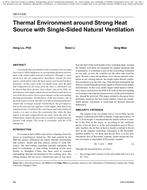With the ever increasing demands for sustainable buildings, engineers are coming up with ever more complex and diversified designs to find ways to reduce loads, boost efficiency, and utilize renewable resources. CFD simulations have become an instrumental tool at Dar Al-Handasah, a multi-national EA consulting firm, to provide state-of-the-art designs for high performance buildings and meet the ongoing challenge of developing models that are energy efficient, sustainable, and LEED compliant. At an early phase in the design process, CFD simulations are extensively used as an optimization and validation tool in supporting the Company’s design process through accurate prediction of thermal comfort conditions, design validation and optimization, and most importantly energy reduction for the HVAC building systems. Specifically, the simulations investigate insightful strategies for design and ingenious air conditioning systems and other energy saving measures that are geared towards decreasing the overall building energy cost, thus, qualifying the design for more points under LEED EA Credit 1, Optimize Energy Performance. Some of the innovative air-conditioning systems include radiant cooling coupled with dedicated outdoor air system (DOAS) in dry climates, under floor air distribution (UFAD) in high assembly spaces and optimized air flow distribution system for open stadia and high ceilinged spaces such as mosques.
Citation: International Conference on Efficient Building Design, Materials and HVAC Equipment Technologies; October 2-3, 2014; Beirut, Lebanon
Product Details
- Published:
- 2014
- Number of Pages:
- 11
- File Size:
- 1 file , 2.3 MB
- Product Code(s):
- D-ICEB14-13


